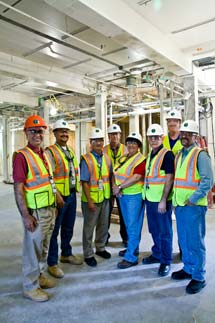
Handy Links
SLAC News Center
SLAC Today
- Subscribe
- Archives: Feb 2006-May 20, 2011
- Archives: May 23, 2011 and later
- Submit Feedback or Story Ideas
- About SLAC Today
SLAC News
Lab News
- Interactions
- Lightsources.org
- ILC NewsLine
- Int'l Science Grid This Week
- Fermilab Today
- Berkeley Lab News
- @brookhaven TODAY
- DOE Pulse
- CERN Courier
- DESY inForm
- US / LHC
SLAC Links
- Emergency
- Safety
- Policy Repository
- Site Entry Form

- Site Maps
- M & O Review
- Computing Status & Calendar
- SLAC Colloquium
- SLACspeak
- SLACspace
- SLAC Logo
- Café Menu
- Flea Market
- Web E-mail
- Marguerite Shuttle
- Discount Commuter Passes
-
Award Reporting Form
- SPIRES
- SciDoc
- Activity Groups
- Library
Stanford
Around the Bay
SAFE09: Out in the Field with the Site Office Safety Team
A pair of steel-toed boots and a hard hat are always within arm's reach, for members of the Environment, Safety and Health and Facility Operations Team at the SLAC Site Office. As representatives of the Department of Energy's Office of Science, the Site Office safety team works together with SLAC's ES&H Division and line management, including University Technical Representatives and ES&H coordinators, to look out for the well-being of the lab's employees.
"This crew gets out quite a bit," said Tom Rizzi, head of the Site Office safety team. Team members spend at least 30 percent of their time out in the field. The idea of having "more boots on the ground" was a response to the challenges the lab faced in keeping a large team of contractors and lab employees safe during construction of the Linac Coherent Light Source.
In 2007, with a year of LCLS construction behind them, the Site Office, SLAC's ES&H Division, and the LCLS project management team and general contractor saw a way to reduce the number of incidents—personal injuries, damage to equipment and procedural mistakes—associated with the project. The four groups united to form a Safety Stewardship Committee that took a big-picture approach to safety on the LCLS construction project.
"The committee was formed to look ahead in the construction schedule for high hazard tasks," said Michael Scharfenstein, the LCLS Directorate's ES&H coordinator. "The idea was to plan rather than react."
The Site Office safety team threw themselves whole-heartedly into the task. They committed to placing more people in the field to provide extra safeguards against possible incidents and to offer insights into how procedures could be improved.
"If work was going on, somebody from DOE was there," Rizzi said. "Whether it was the early shift, swing shift, owl shift or the weekend, we were there."
Scharfenstein said that Site Office partnership boosted SLAC's safety performance. "They came out with a positive attitude toward the work, wanting people to be successful while at the same time helping people be safe," he said.
The strategy worked—during the second year of construction, the number of incidents "was significantly lower," Rizzi said.
As a consequence, the Site Office staff have now changed their approach to safety oversight in general. "Now we're following a similar model to that used during LCLS construction. We're out in the field more, looking at hazards and repeat issues," said Rizzi, who worked in SLAC's ES&H Division before joining the Site Office in 2006. Instead of "nit-picking," he said, his office seeks safety solutions with a broader positive impact.
"We look at the process instead of each piece, and use trending to see patterns," he said. "If nits turn into a trend, then we can fix the big thing which fixes all the nits—it just rolls downhill."
"My experience with [the Site Office] has been very positive," Scharfenstein noted. "Tom and his team do a tremendous job of providing assistance and guidance to help us interpret DOE orders and headquarter expectations so we're successful. That's very important."
—Lauren Schenkman
SLAC Today, May 6, 2009
